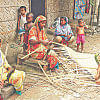The smartest ways to fight non-communicable diseases in Bangladesh
Infectious diseases get all the attention. And for a long time, these diseases were what most people around the world died from. But as we are increasingly beating back infections and live to grow older, we start dying from what doctors call non-communicable diseases (NCDs), like heart disease, strokes, cancer, and diabetes.
Bangladesh has seen the same pattern. A study of the rural area Matlab showed that from 1986 to 2006, the share of deaths caused by communicable diseases fell from 52 percent to 11 percent. During the same period, deaths from NCDs increased from 8 percent to 68 percent. Today, NCDs are the largest killer nationwide, responsible for 59 percent of all deaths.
Of course, Bangladesh faces many health challenges, and additional ones outside health. Where should she focus her limited resources first?
A new research paper, LINK, written by four eminent American economists, examines several strategies to combat non-communicable diseases in Bangladesh. They find that the most cost-effective solutions are those aimed at reducing hypertension and tobacco use.
Bangladesh already has an extensive network of 14,000 community clinics that span the country, and even in rural areas, most homes are within half an hour walking distance of a clinic. This pre-existing infrastructure presents an opportunity to fight NCDs cost-effectively.
Hypertension, or abnormally high blood pressure, is not only very prevalent in Bangladesh, it's also a primary risk factor for more serious conditions, including heart disease, stroke, and diabetes. There's a very good chance that you or someone you know suffers from the disease - one in three women and one in five men over age 35 have hypertension. But treatment is straightforward and fairly cheap: annual costs are about Tk. 7,000 for each person to cover screenings as well as medications like aspirin.
Given the prevalence of high blood pressure, this solution could do a lot of good for a lot of people. Three quarters of all patients treated can expect to live three years longer on average. Overall, each taka spent toward these efforts over the next five years would give Tk. 37 of benefits.
Tobacco is also related to heart disease and is a big killer in Bangladesh: each year, 70,000 people die from tobacco-related causes. While men primarily smoke tobacco, and women generally use smokeless products, an estimated total of 41.3 million people over age 15 use tobacco of some sort - two out of every five people in that age group.
In many countries, taxing cigarettes has significantly reduced smoking. The researchers propose a tax on all tobacco products - and strict enforcement of the tax. Currently, tobacco is taxed at 35 percent of retail price, but the tax is often not enforced. A strictly enforced tax that rises to 50 percent of retail price by 2021 would reduce demand of tobacco products by 7 percent. The revenues that such a tax raises would offset the entire cost of implementing it. And the lowered tobacco consumption would avert more than 5,000 deaths each year over five years. Each of these people would live at least 10 years longer than they would otherwise.
If you add up the value of all these benefits, increasing the tobacco tax to 50 percent over the next five years would do Tk. 8 of good for every taka spent.
A third chronic illness that the researchers examine is cervical cancer. It is one of the most deadly cancers for women in Bangladesh—it causes about 10,000 deaths each year. Although we know how to help, it turns out to be rather costly. The experts find that investment to vaccinate, screen, and treat cervical cancer would provide less than half a taka in benefits for each taka spent. As awful as this disease is, we have to consider whether there are other and better places a taka can be spent to help more women and men survive, for instance, in tackling high blood pressure.
As this new research shows, there are many ways to help combat non-communicable diseases in Bangladesh—and many other issues to tackle beyond them.Where would you choose to spend money if you could decide how to do the most good for Bangladesh? Let us hear from you at https://copenhagen.fbapp.io/ncdpriorities. We want to continue the conversation about which solutions can do the most good for Bangladesh for every taka spent.
The writer is president of the Copenhagen Consensus Center, ranking the smartest solutions to the world's biggest problems by cost-benefit. He was named one of the world's 100 most influential people by Time magazine.

 For all latest news, follow The Daily Star's Google News channel.
For all latest news, follow The Daily Star's Google News channel. 








Comments